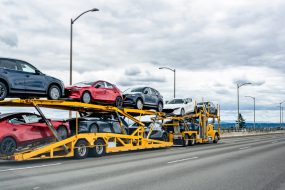The automotive industry has always moved at full throttle. But now, it’s data that’s driving the change. From smarter supply chain analytics to streamlined warehousing and distribution, data is redefining how the world’s most complex logistics networks operate.
For any automotive logistics provider, the ability to turn data into insight is no longer a competitive edge — it’s vital. Whether it’s predicting supply disruptions, reducing downtime, or optimising delivery routes, data analytics is quietly transforming how the industry delivers efficiency, reliability and innovation.
Related Reading: Automotive logistics made easy: a strategy guide
The rise of data-driven automotive logistics
Data analytics refers to the process of examining large volumes of information to identify patterns, trends and actionable insights. In automotive logistics, this means using real-time data to make smarter decisions at every stage — from sourcing raw materials to delivering finished vehicles.
At its core, data analytics empowers automotive logistics providers to move from reactive problem-solving to proactive decision-making. Rather than waiting for bottlenecks or disruptions, companies can use data to see them coming — and prevent them entirely.
Smarter decisions through supply chain analytics
Supply chain analytics is where the power of data really comes to life. By analysing data from across production lines, transport routes, and storage facilities, businesses can identify inefficiencies that would otherwise go unnoticed.
For example, predictive analytics — a branch of data analytics that uses historical data to forecast future outcomes — helps automotive firms anticipate demand fluctuations and plan inventory accordingly. This means fewer stockouts, less overproduction, and far more efficient warehousing and distribution operations.
Imagine knowing that a specific part will soon face a shortage before it happens or predicting when seasonal demand will surge. That’s the precision that supply chain analytics offers — and in an industry built on timing, it’s invaluable.
Related Reading: Enhancing automotive logistics with technology
Real-time visibility for smoother operations
In logistics, visibility is everything. With connected systems and tracking technology, automotive logistics providers can monitor shipments and inventory in real time — and act instantly if something goes off track.
This kind of real-time data is reshaping how companies manage transportation and delivery. When a delay occurs, automated alerts and predictive tools can reroute shipments, update schedules, and keep customers informed without a single phone call.
The result? Faster, more transparent, and more reliable operations — exactly what both manufacturers and consumers expect in a data-driven supply chain.
Optimising warehousing and distribution with data
Warehousing and distribution are key areas where analytics can deliver measurable impact. By examining data on inventory movement, order frequency, and fulfilment times, logistics teams can design smarter warehouse layouts, reduce idle stock, and streamline pick-and-pack operations.
Advanced inventory tracking systems also allow businesses to analyse how goods flow through their facilities, uncovering patterns that lead to more efficient resource use. Combined with route optimisation tools, data analytics helps determine the fastest, most cost-effective delivery paths — reducing fuel consumption and lowering operational costs.
For an automotive logistics provider, this kind of efficiency isn’t just about saving money; it’s about maintaining the level of precision and reliability that the industry demands.
Related Reading: The biggest shifts in automotive logistics right now
The benefits of embracing data analytics
Companies that successfully harness data analytics in automotive logistics enjoy tangible advantages:
- Improved decision-making: Real-time insights enable faster, more confident decisions across production, transportation and warehousing.
- Increased operational efficiency: Streamlined workflows and reduced downtime translate to faster, leaner logistics operations.
- Enhanced customer experience: Reliable delivery schedules and accurate tracking boost satisfaction and strengthen relationships.
- Agility in uncertain markets: Data provides the flexibility to adapt to demand shifts, supply disruptions and changing regulations.
Data-driven operations allow automotive logistics providers to move with precision — not guesswork.


Overcoming the challenges
While the potential of data analytics is vast, implementation can be complex. It requires investment in the right technology, robust data infrastructure, and teams skilled at interpreting insights.
However, the long-term benefits easily outweigh the challenges. Companies that commit to digital transformation and build a data-first culture are better positioned to adapt, innovate, and lead in an increasingly competitive market.
Related Reading: Smarter supply chains: How tech is transforming auto logistics
What’s next for automotive logistics?
The future of automotive logistics lies in deeper integration between technology and data. Artificial intelligence and machine learning are already helping companies refine forecasts, automate decision-making, and uncover new efficiencies that humans might miss.
The Internet of Things (IoT) is also set to accelerate progress, connecting vehicles, equipment, and infrastructure in a seamless data ecosystem. Real-time supply chain visibility, once a luxury, will become the industry standard.
Finally, sustainability will play an increasingly central role. Data analytics enables logistics providers to track emissions, optimise routes, and reduce waste — making environmentally responsible logistics both achievable and measurable.
Key Takeaway
Data is now the driving force behind automotive logistics. From predictive analytics and supply chain optimisation to smarter warehousing and distribution, its impact touches every part of the process.
By embracing data analytics, automotive logistics providers can achieve the agility, transparency, and efficiency needed to meet the demands of a fast-changing industry — and stay firmly in the driver’s seat of innovation. Interested in what’s next? Reach out today.




